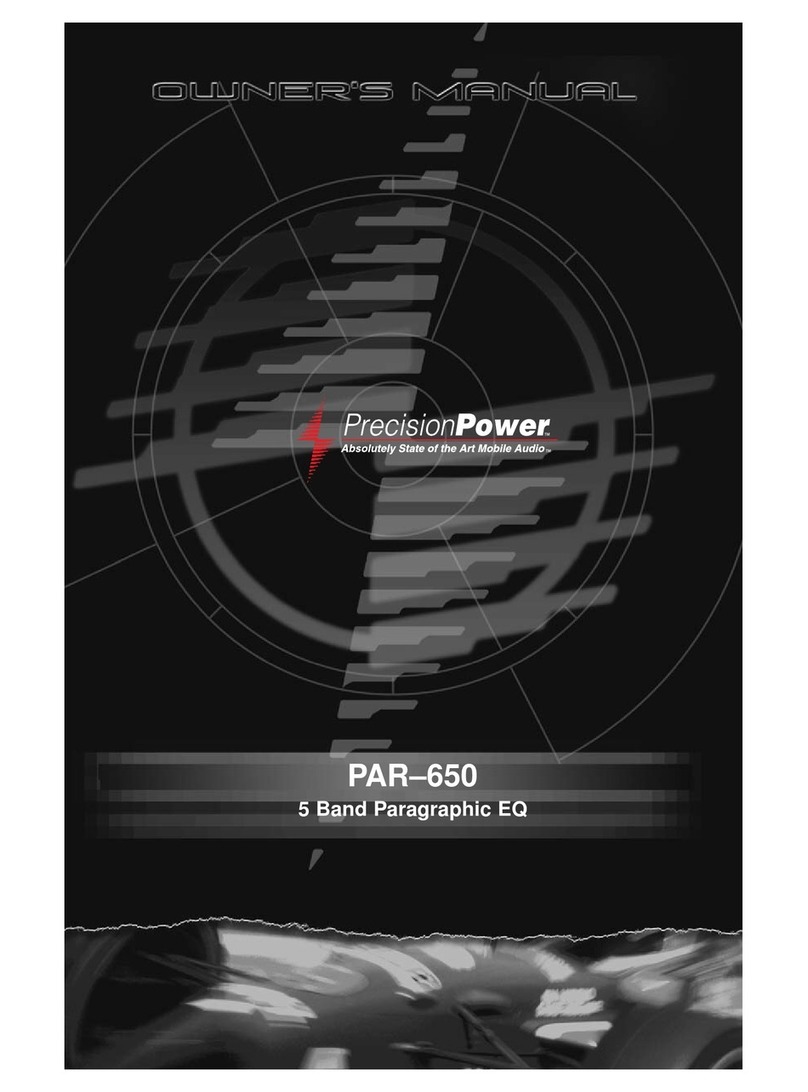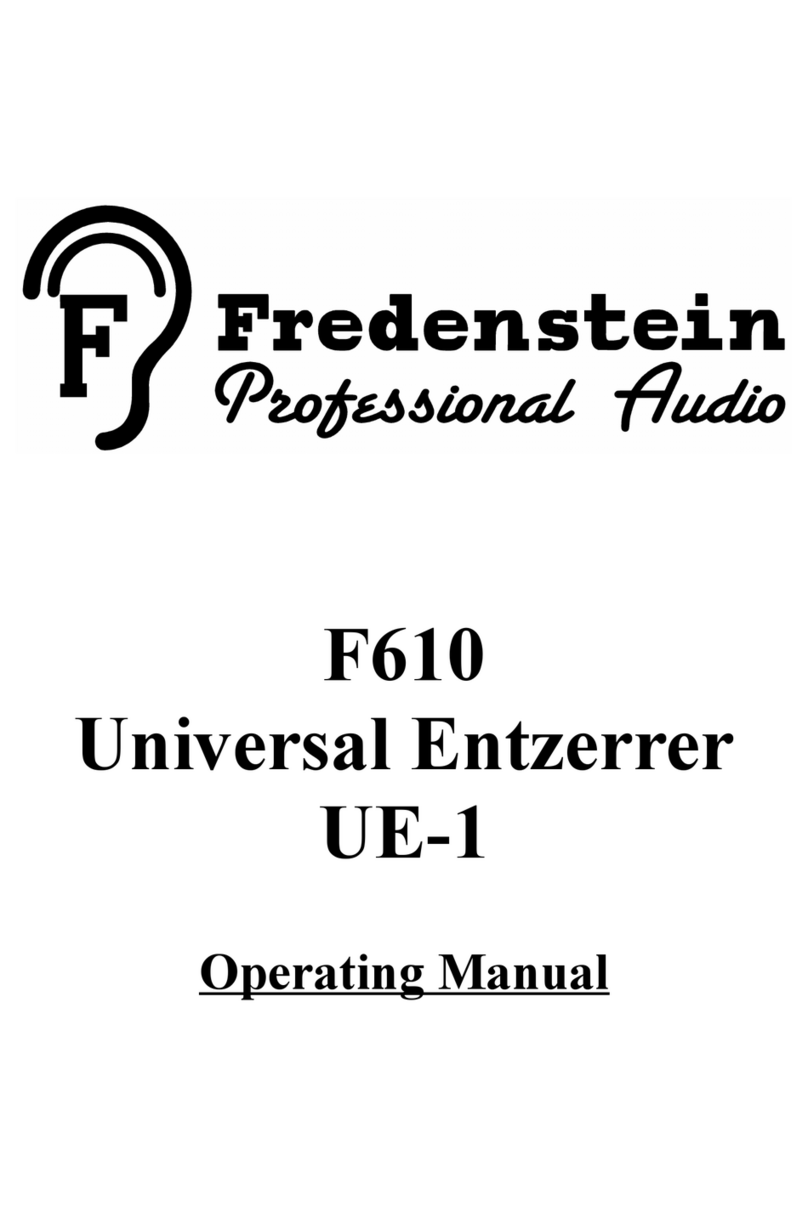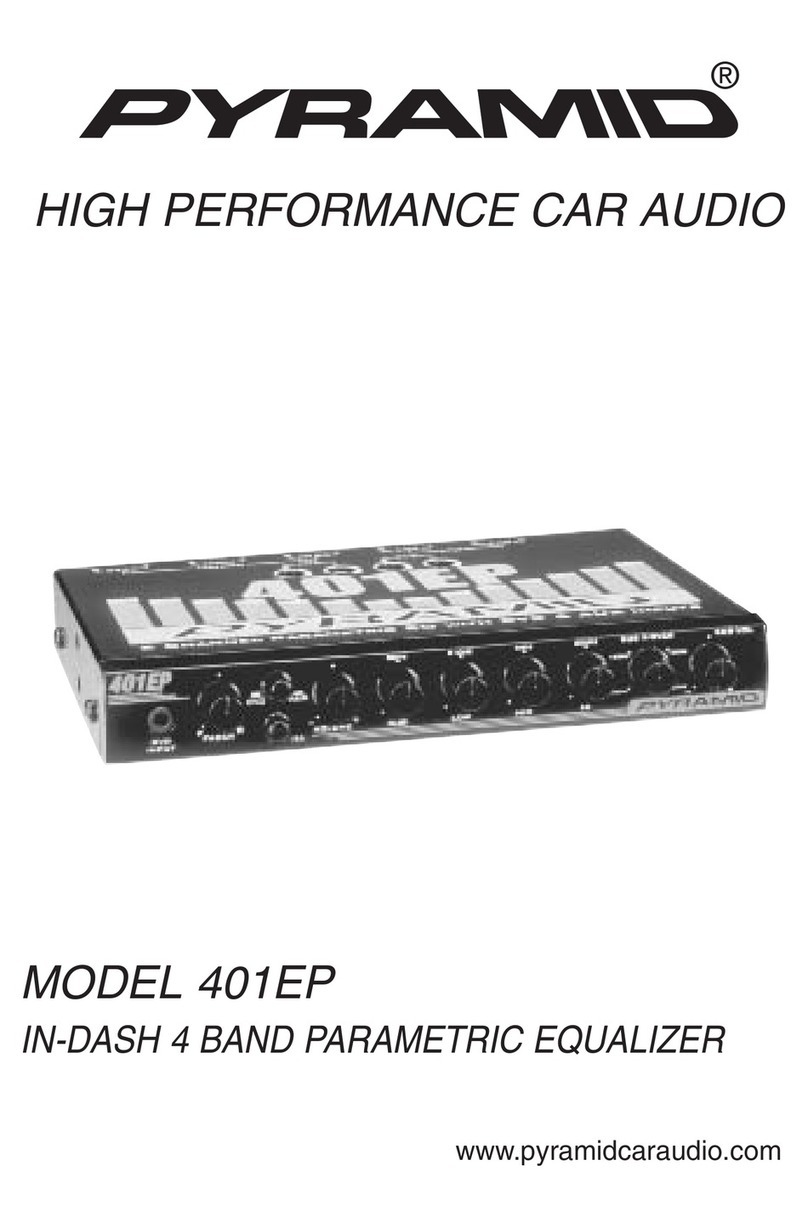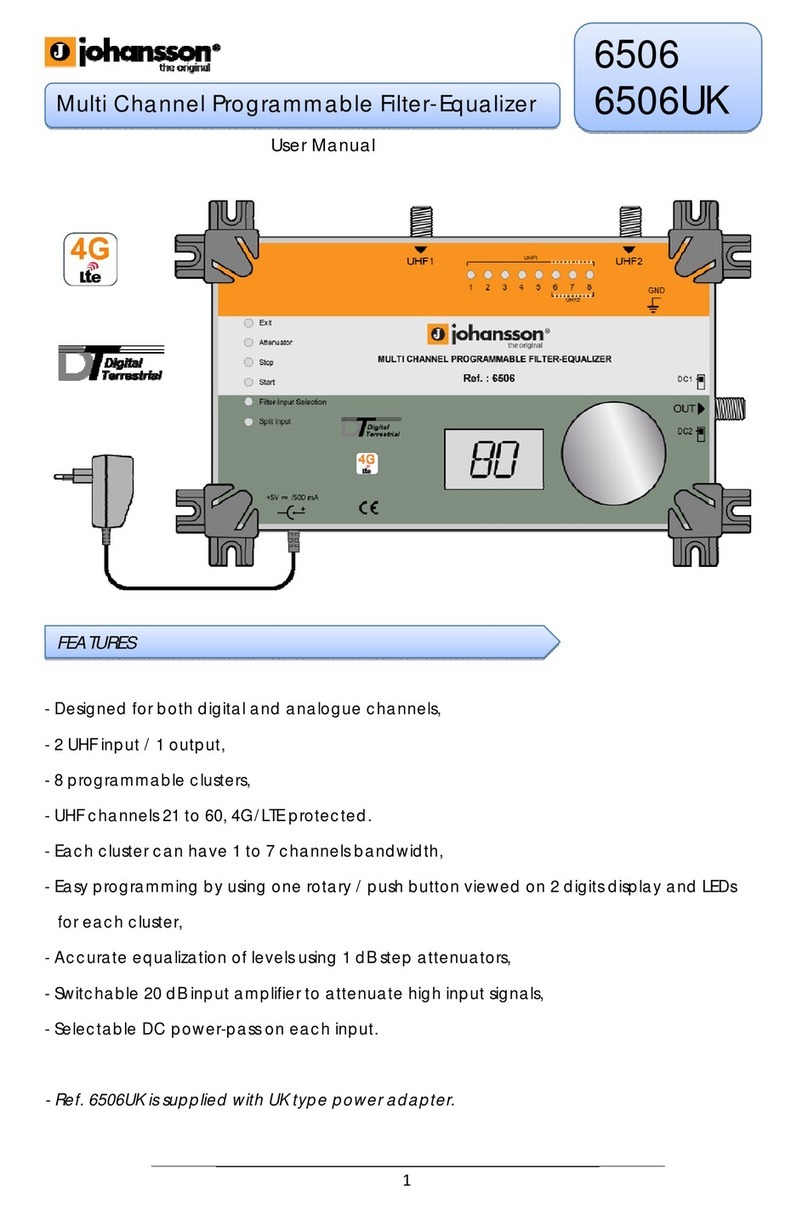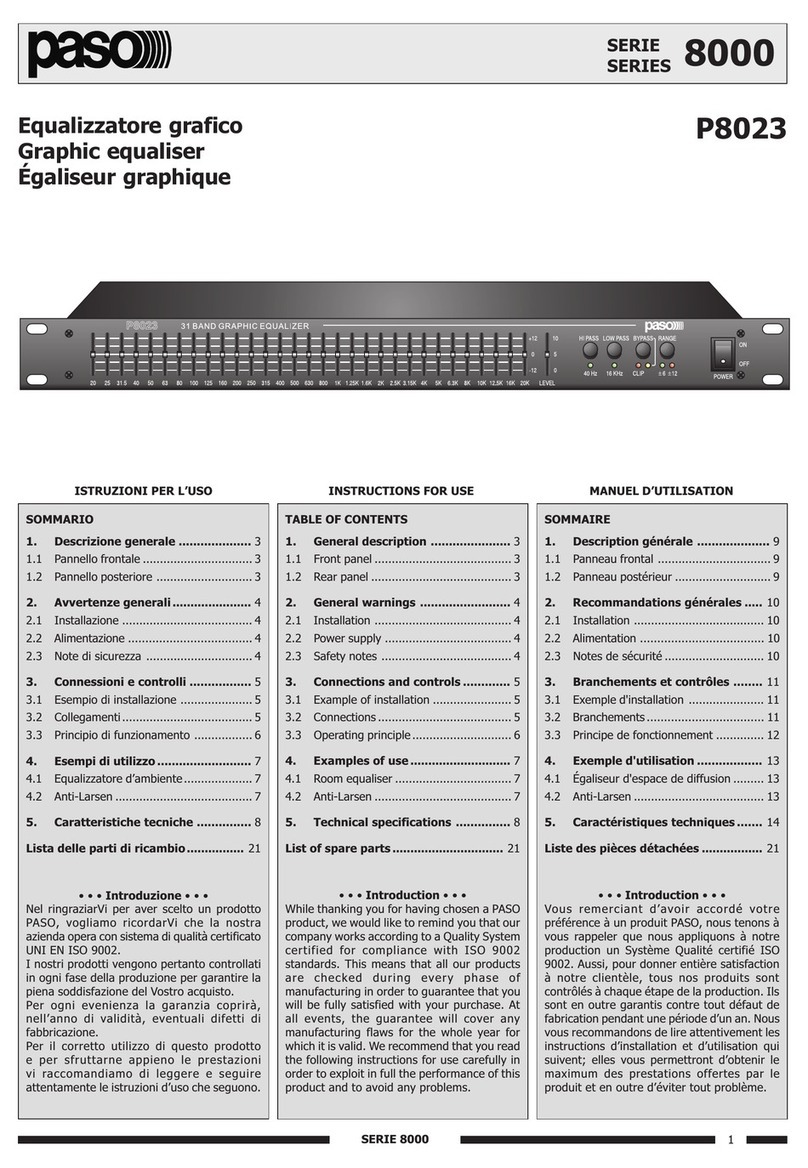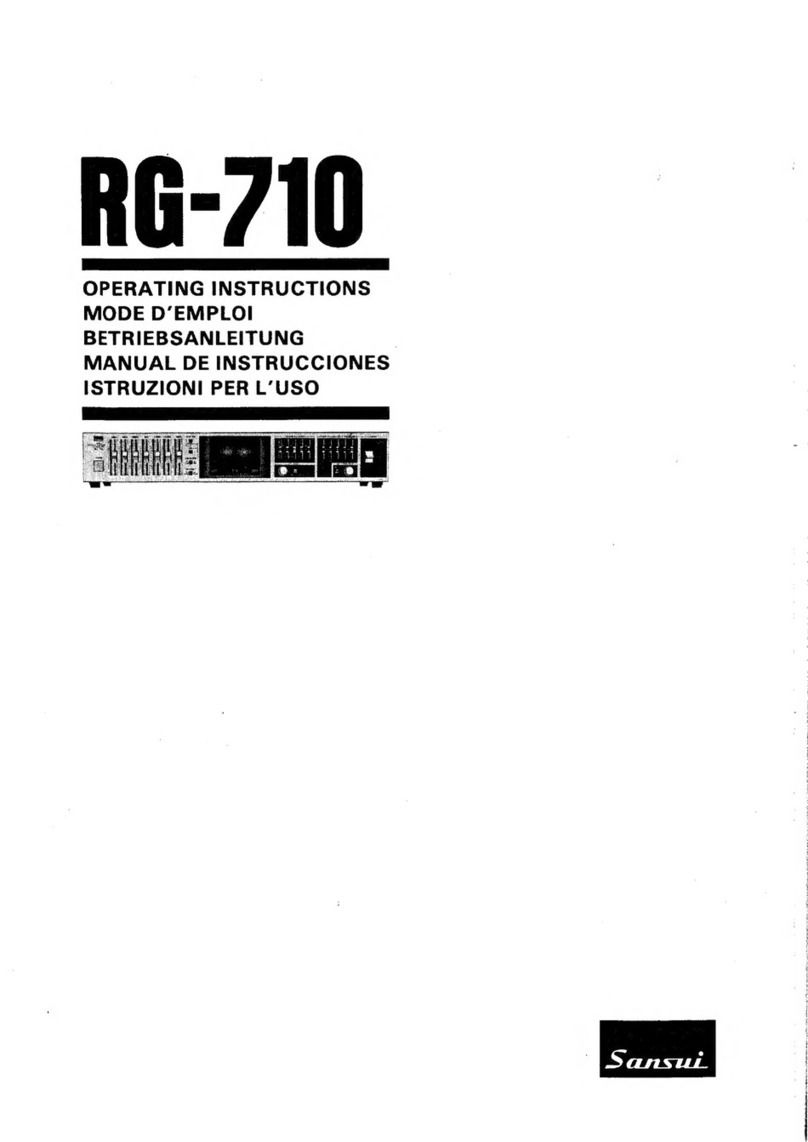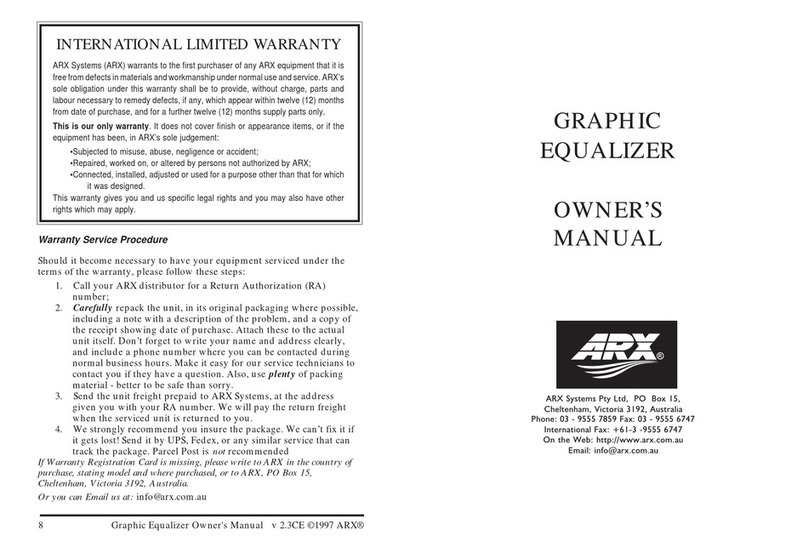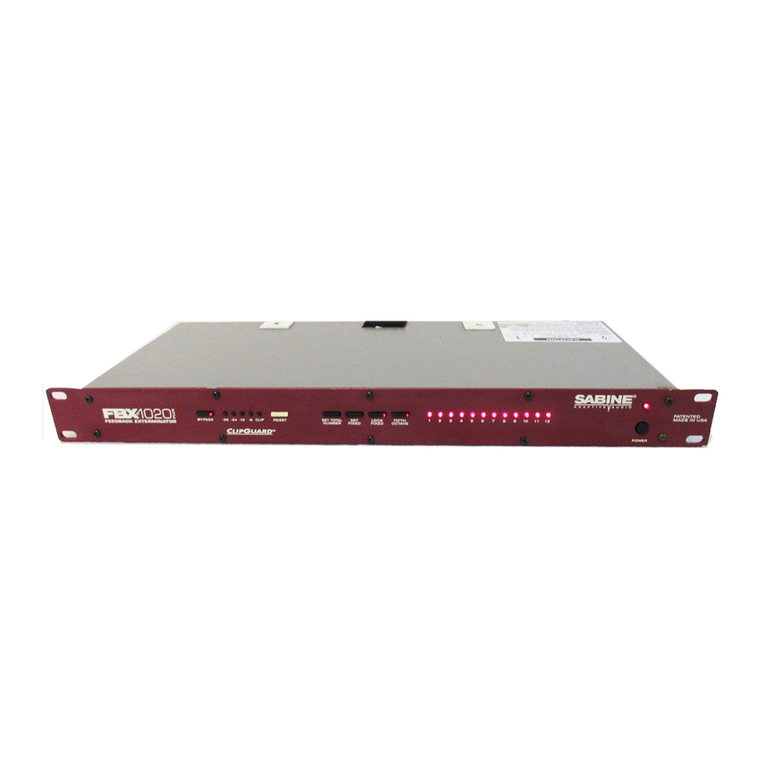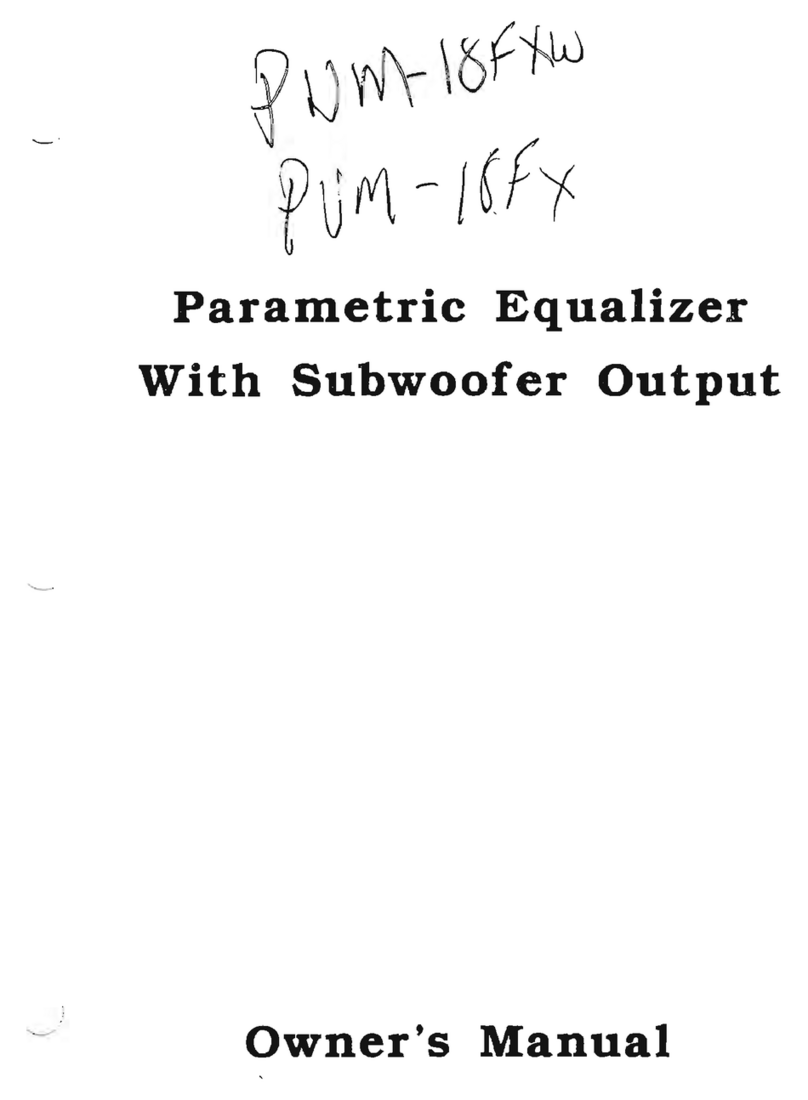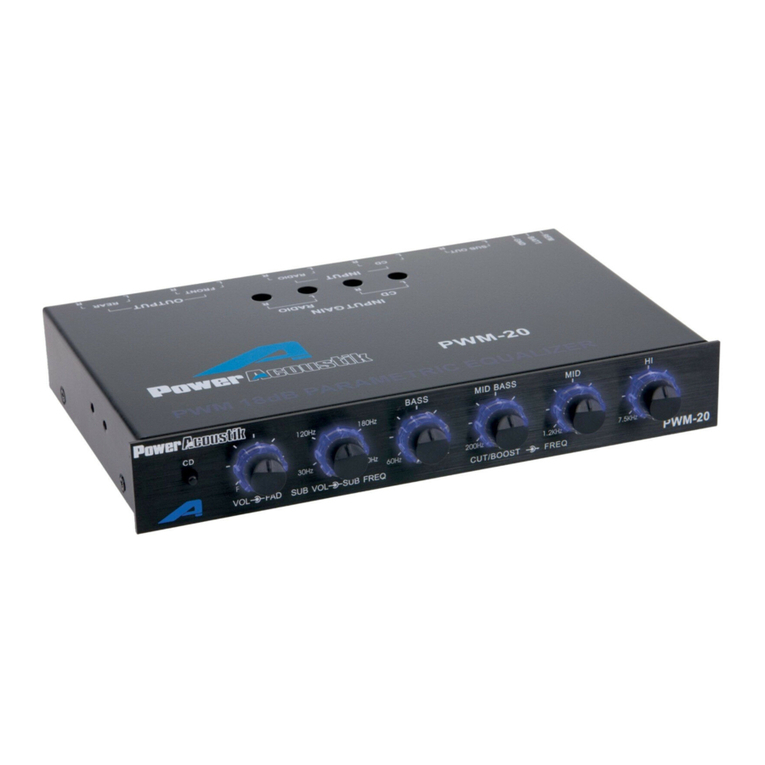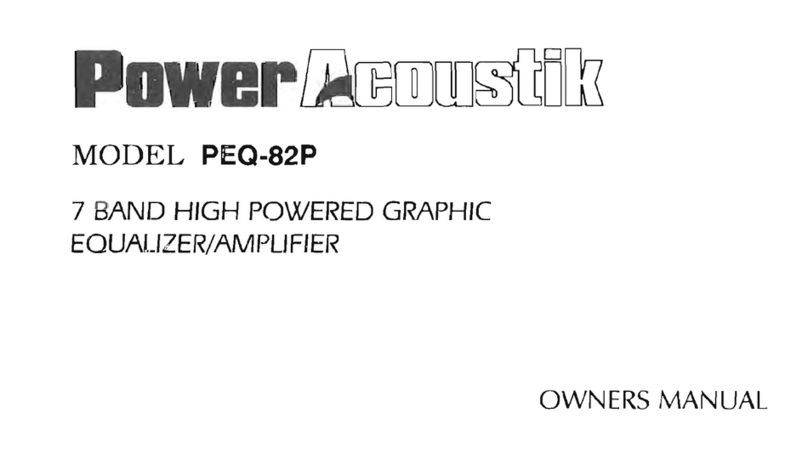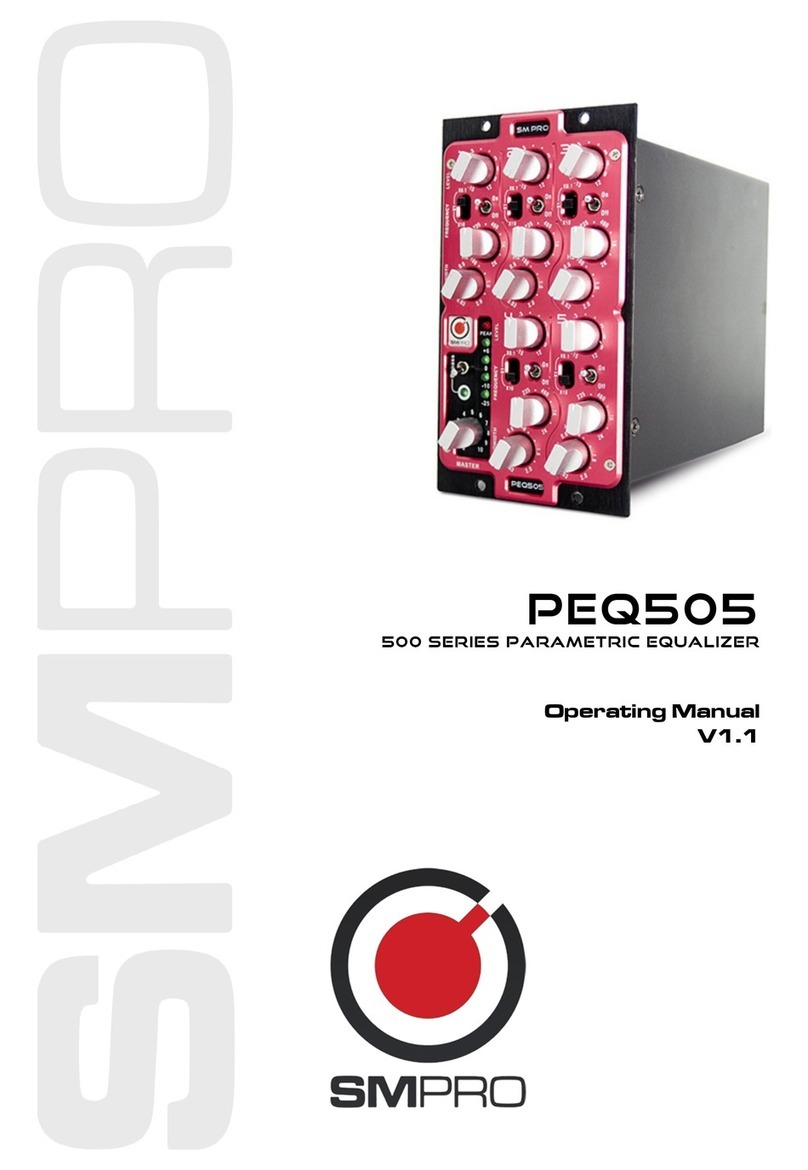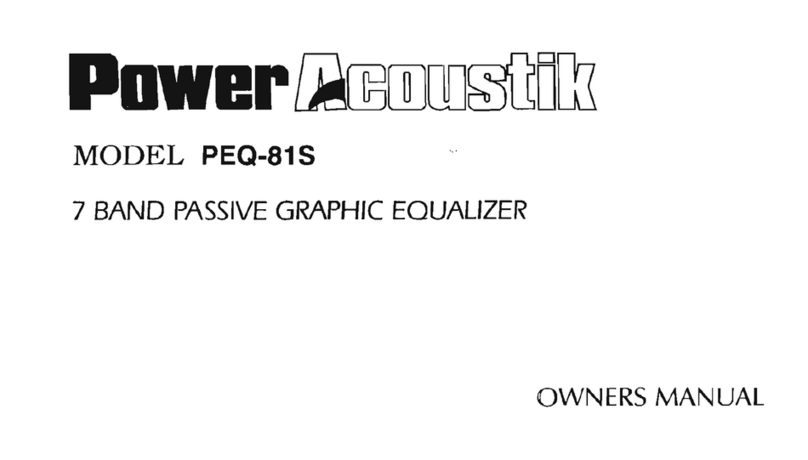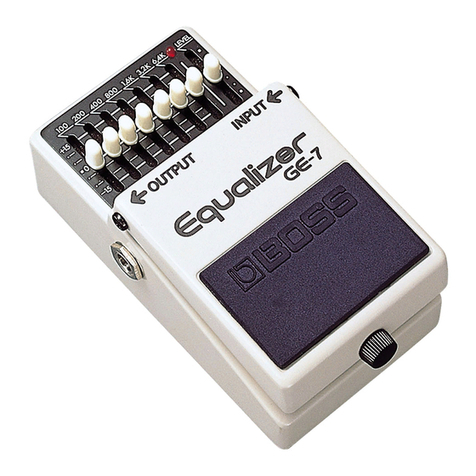Psidex Audio Laboratory PEQ-1 User manual

1
DESCRIPTION
The PSIDEX PEQ-1 is a modern version of the famous “Pultec” equalizer popular during the
1950– 1960 period. Like the original, this design employs vacuum tube gain stages and a high
quality passive LCR equalizer network, long known for it’s robust, low distortion performance.
This modern design offers lower distortion and noise over the original, in addition to more
frequency choices. A dual regulated high voltage power supply is used to provide plate voltage
along with a regulated heater supply. This power supply uses toroid magnetics to reduce magnetic
noise both internally and externally.
Modern features include conductive plastic potentiometers for high frequency boost and width
along with stepped switch controls for low frequency boost and cut and high frequency cut.
Polypropylene and polystyrene capacitors are used in the signal and frequency determining
circuits. The input and output line transformers are hand-wound for low capacitance and leakage
inductance and use modern high quality core materials and are magnetically shielded.
The makeup-gain line amplifier is a minimal feedback single ended Class A design. This approach
allows for a minimum parts count, which contributes to low noise and low distortion. Two vacuum
tubes are used in the amplifier. Signal input and output modes are independently switchable for
600 ohm balanced or high impedance, unbalanced, operation.
SPECIFICATIONS
EQUALIZER SECTION
BOOST FREQUENCIES
L.F
20, 30, 60, 100, 150 Hz, 14 dB in 1 dB steps., shelf
H.F
1, 2, 3, 4, 5, 6, 8, 10, 12, 14, 16, 18 kHz, 20 dB +/-1 dB peaking, continuously variable with
variable peak width.
CUT FREQUENCIES (ATTENUATE)
L.F
20, 30. 60, 100, 150 Hz, 18 dB in 1 dB steps., shelf
H.F
5, 10, 15, 20 kHz, 16 dB in 1 dB steps., shelf

2
LINE AMPLIFIER
GAIN
Unity, with +/- 5 dB Adjustment Range. (Amplifier gain for Eq. make-up typ. 23 dB)
FREQUENCY RESPONSE
10 Hz to 48 kHz +/- 0.5 dB in Balanced Mode.
20 Hz to 50 kHz +/-0.5 dB in Unbalanced Mode.
NOISE
>90 dB below +10 dBm, A weighted.
HARMONIC DISTORTION
Less than 0.015% at +10 dBm output into 600 ohms.
Less than 0.008% at 0 dBm output into 600 ohms.
MAXIMUM OUTPUT
+26 dBm into 600 ohms.
EFFECTIVE SOURCE IMPEDANCE
47 ohms for 600 ohm output.
960 ohms for unbalanced hi-z output.
INPUT IMPEDANCE
Balanced input 600 ohms terminated.
Unbalanced hi-z input 100k resistive.
CONTROLS, FRONT PANEL
EQUALIZER IN/OUT
Lever type Rocker Switch, Gold Contacts
EQUALIZER LF BOOST, CUT; HF CUT
Rotary Elma, Gold Contacts
EQUALIZER HF BOOST, WIDTH
Rotary Potentiometer, Conductive Plastic
FREQUENCY SELECT
Rotary Grayhill, Gold Contacts
POWER
Alternate action Push Button
POWER INDICATOR
Red Led

3
CONTROLS, REAR PANEL
INPUT MODE, BALANCED- UNBALANCED
Low Profile Rocker Switch, Gold Contacts
OUTPUT MODE, BALANCED- UNBALANCED
Low Profile Rocker Switch, Gold Contacts
OUTPUT PHASE, BALANCED MODE
Low Profile Rocker Switch, Gold Contacts
OUTPUT TERMINATION, BALANCED MODE
Low Profile Rocker Switch, Gold Contacts
GAIN ADJUSTMENT
Screwdriver Adjust, Conductive Plastic
CONNECTORS, REAR PANEL
INPUT, BALANCED
3 pin XLR Female
INPUT, UNBALANCED
¼ inch Diameter Phone Jack
OUTPUT, BALANCED
3 Pin XLR Male
OUTPUT, UNBALANCED
¼ inch Diameter Phone Jack
POWER
Standard 3 Wire IEC Type with Integral Fuse 5 x 20 mm.
FUSE RATING
120 volts 0.315 Ampere, 240 volts 0.160 Ampere, both to be Time Delay type.
VACUUM TUBES
Two Nine Pin, Accessible Thru Access Port. Tubes are fully enclosed within chassis.
VACUUM TUBE COMPLIMENT
One each, 6414, 12AX7 / ECC83

4
MISCELLANEOUS
INPUT POWER
120/ 240 Volts AC 22.6 VA. Input voltage selection via internal jumpers.
PHYSICAL SIZE
Front Panel, 19 inches wide (48.26), 1.75 inches high (4.445). Equal to 1U rack standard.
Chassis, 17 inches wide (43.18), 11.60 inches behind panel (29.46).
Overall depth, 12.45 inches (31.62) including panel knobs.
( ) Dimensions in cm.
WEIGHT
7.75 pounds (3.52 kg)
FINISH
Panel, Dark Grey textured powder coat.
Chassis, Black anodize.
Markings, white epoxy paint.
MATERIALS/ QUALITY
Panel, aluminum, 0.125 thick.
Chassis, aluminum, 0.0625 thick.
Wiring, MIL M2759/11, MIL M27500, MIL-W- 16878E Teflon.
Soldering, to IPC610A.
INSTALLATION
Installation of the PEQ-1 is straightforward. Unit can be rack mounted using appropriate
hardware. Mounting screws should be used with a nylon washer or be of the non-marring type to
prevent damage to the panel finish. CAUTION: BE SURE THE AC POWER SUPPLY YOU
ARE USING IS SAME AS THAT MARKED ON THE UNIT REAR LABEL. Domestic (USA)
units are shipped strapped for 120 volt operation. See instructions at the end of this section for
changing operating voltage setting.
Always provide for adequate air circulation around the PEQ-1 chassis. Doing so will increase
product life by reducing temperature rise. Tube based equipment can run warm to hot!
Plug the line cord into the PEQ-1 IEC power inlet and connect to a proper ac power source. Press
POWER switch and power led indicator will light to show unit is ready for operation. Allow a 2
minute warm up time.
The input and output configuration can be selected for the following modes: see Figure 1 below.
BALANCED INPUT- OUTPUT
Set both the Input and Output switches to the BAL position (towards the XLR connectors).
UNBALANCED (HI Z) INPUT – OUTPUT
Set both the Input and Output switches to the HI Z position (towards the phone jacks).

MIXED INPUT- OUTPUT
Input and Output switches can be set for mixed input/ output impedances; HI Z in, BAL out or
vice versa. It should be noted that the PHASE reverse switch is effective for BAL output only.
Figure 1
PHASE REVERSE
The PHASE reverse switch transposes the BALANCED output polarity to permit correcting an
input which may be phase reversed. This feature can be used only when the output switch is set
for BAL mode.
OUTPUT TERMINATION
This switch places a 610 ohm resistive load across the BAL line output. This switch should be in
the I (IN) position when feeding a known un terminated load. Switch to the O (OUT) position
when the load is known to be internally terminated. Proper termination will preserve low
distortion and maintain headroom.
INPUT/ OUTPUT CONNECTIONS
The following describes the input connector pin wiring convention:
BALANCED INPUT BALANCED OUTPUT HI Z UNBAL INPUT OUTPUT
1- CHASSIS 1- CHASSIS TIP- SIGNAL
2- SIGNAL + 2- SIGNAL + RING- CHASSIS
3- SIGNAL - 3- SIGNAL - SLEEVE- CHASSIS
Table1
A positive voltage on pin 2 of the BAL input connector or on the TIP of the HI Z input will
produce a positive voltage on pin 2 of the BAL output or on the TIP connection of the HI Z output
connector The signal polarity referenced above is for the NORMAL position of the PHASE
switch. The signal polarity of the Balanced Output will be reversed in the PHASE REVERSED
position
5

GAIN ADJUSTMENT
The PEQ-1 is shipped with gain set for unity. The gain is user adjustable over an approximate
range of +/- 5 dB. The GAIN adjustment is located on the tube panel and can be accessed through
the tube port at the rear of the unit. Gain increases for clockwise rotation of the GAIN pot.
LINE VOLTAGE SELECT
The PEQ-1 is strapped for 120 volt ac operation for all units shipped in the U.S and to Canada.
The unit may be set up for 240 volt ac operation by replacing the 4 wire connector at P4 with a
connector arranged for 240 volt operation. P4 is located on the power supply pcb. CAUTION:
THE MAINS LINE FUSE MUST BE CHANGED TO A RATING OF 0.160 AMPERES, TYPE
T, FOR 240 VOLT OPERATION. A PROPER FUSE MUST BE USED TO MAINTAIN
PRODUCT SAFETY. A connector and fuse kit can be obtained from Psidex for making 240 volt
conversion.
Figure2
OPERATION
Operation of the PEQ-1 is straight forward and intuitive. A run down of the front panel controls is
discussed in this section.
EQUALIZER IN OUT SWITCH
This switch places the equalizer network circuits into the signal - line amplifier path when in the
up position. The line amplifier is active at all times with power applied.
LOW FREQUENCY CONTROLS
The LF HZ switch selects the frequency curve on which the LF CUT and LF BOOST operate.
The Cut and Boost controls are step switches which determine the attenuation or boost amplitude
of the selected curve. Adjust these controls as required for the degree of low frequency effect
needed. Attenuation and boost is in 1 dB steps. Appendix A-LF shows representative curves.
HIGH FREQUENCY CONTROLS
The CUT KHZ switch selects the frequency curve on which the HF CUT will operate. The
Cut control operates in 1 dB steps to provide the required degree of attenuation at the frequency
selected. Appendix A-HF1 shows representative curves.
The BOOST KHZ selects the frequency on which the BOOST KHZ will operate. The Boost
Control is a potentiometer and can provide excellent resolution. This sets the amplitude of the
selected peak frequency. Maximum boost is with this control in the full clockwise position. The
HF WIDTH control is also a pot and determines the width (“Q”) of the selected peak.
Sharpest peaking is with the control in the fully clockwise direction Appendix A-HF2 and 3 show
representative curves.
6

7
The CUT KHZ and the BOOST KHZ controls may be used together to achieve the effect desired.
For example, roll off could be at a higher frequency while brightening up a lower frequency.
Deficiencies in the program material can very often be eliminated by judicial use of both peaking
and frequency cut.
CONNECTIONS
The Input and Output connections should be made in accordance to the wiring convention shown
in Table 1 of this manual. The Input and Output configurations can be switched to allow the use
of mixed Input and Output impedances. See Figure 1 of this manual for details.
INPUT LEVELS
It is best to operate the PEQ-1 with input levels between 0 and +10dBm when in the Balanced
mode. This will insure adequate headroom when using program requiring large amounts of boost.
The “soft” overload characteristics of a tube system is often less objectionable than the harsh
overload sound of typical solid state designs, but for good program quality it is best to avoid
overload. Most audio devices having Unbalanced ( Hi Z) outputs will have output voltages
between 0.5 and 2 volts rms. A 2 volt signal into the Hi Z input will result in an output of
approximately +8 dBm at the Balanced output. This is a good operating level and it can be
trimmed with the gain adjust, if desired.
SERVICE NOTES
Other than the eventual replacement of vacuum tubes V1 (12AX7) and V2 (6146), there should be
no need for routine service of the PEQ-1. The front panel can be cleaned with a soft cloth. No
harsh solvents or abrasives should be used
The PEQ-1 contains hazardous voltages as is common in vacuum tube equipment. Any
required service is best left to qualified service personnel.
TUBE REMOVAL AND REPLACEMENT
Both tubes are easily removed via the tube access port at the rear of the unit. Remove the tube
shield by pressing in and rotating slightly counter clockwise to clear the shield J retaining slot,
then pull out to remove shield. In units equipped with wire clip retainer, slip the retainer spring
away from the tube so that it is off to the side. Carefully pull tube to remove from socket. Do not
rock to side as this can damage tube socket.
CAUTION: ALWAYS ALLOW TUBES TO COOL FOR AT LEAST 5 MINUTES AFTER
REMOVING POWER TO AVOID BURNS. TUBES CAN REACH TEMPERATURES
HIGH ENOUGH TO INFLICT PAINFUL BURNS UPON CONTACT WITH
UNPROTECTED SKIN.
Replace tubes with the proper type as shown in the Specification section of this manual. It is well
known that all tubes are not created equal and some will perform better than others. Experience
has shown that quality brands of tubes will offer better performance and service then cheap off
brands. The exception to this rule may be guided by the users experience and practice. Some older
NOS (new old stock) tubes from the 1950’s and 60’s will very often perform and sound better
than current manufactured tubes. If in doubt, replacement tubes can be ordered from Psidex.
Insert tube into socket with tube pins in proper alignment with socket. Press tube into socket using
only nominal force. Be sure tube is fully seated in socket. Replace shield by placing shield to
receive the J slot socket “bumps”. Press in and rotate slightly clockwise to engage J slot bayonet.

8
WARRANTY
The standard warranty coverage is one year for components and workmanship, with a 45 day
warranty for vacuum tubes. This warranty is from the date of purchase. For more warranty
information, please refer to the warranty card supplied with this unit. PLEASE NOTE THAT THE
WARRANTY IS LIMITED OUTSIDE THE USA.
Psidex Audio Laboratory reserves the right to change or otherwise modify product description or
design to maintain quality and performance.
Psidex Audio Laboratory is a product line of Paradyne Systems Inc.
69 Manor Drive, Cheshire Ct 06410 USA
Tel 203.272.3638 Fax 203.271.1395
Rev a 12-2-2009
Rev b 2-18-2010
Rev c 2-5-2011
Rev d 5-7-2012

TYPICAL RESPONSE CURVES
APPENDIX A-LF
9

TYPICAL RESPONSE CURVES
APPENDIXA-HF1
TYPICAL RESPONSE CURVES
10

APPENDIX A-HF2
TYPICAL RESPONSE CURVES
11

APPENDIX A-HF3
12

13
Table of contents
